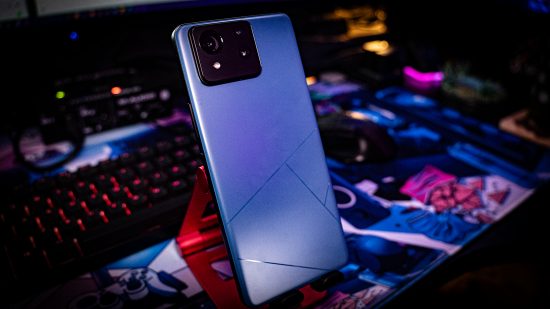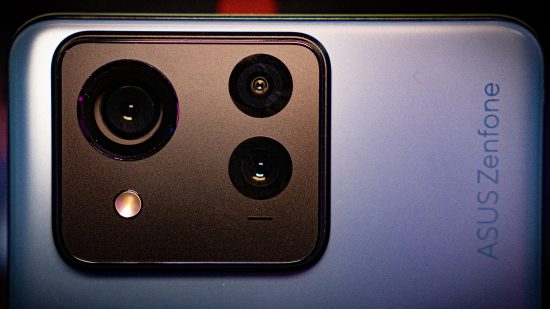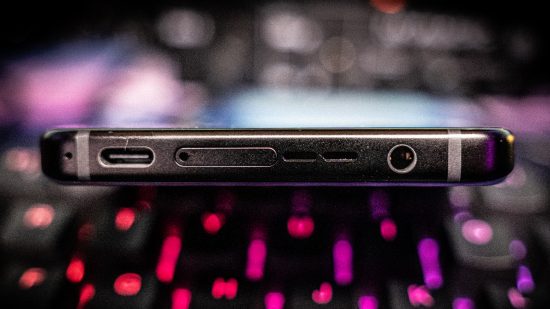Our Verdict
The ASUS Zenfone 11 Ultra is a competitive flagship smartphone, with a fantastic display, stellar performance, and handy cameras. However, it's also quite expensive, lacks meaningful innovation, and it's build might be too big and bulky for some.
- Exceptional camera performance with a 3-camera setup
- Vivid and bright 6.78" E6 OLED display
- Powerful Snapdragon 8 Gen 3 processor
- Long-lasting battery life
- Innovative AI features for an enhanced user experience
- Premium price point might deter budget-conscious buyers
- Large size may not appeal to users preferring compact devices
ASUS is aiming to innovate with its new and oddly named premium offering, the ASUS Zenfone 11 Ultra. It’s not just another entry in the lineup; it’s a bold statement from the brand. Designed to exceed expectations, the Zenfone 11 Ultra marries cutting-edge hardware with software innovations tailored for the modern user. Whether a tech enthusiast or a daily grinder, this phone promises to elevate your mobile experience with quality performance, captivating aesthetics, and seamless practicality.
While the idea of a premium version of a handset that doesn’t exist is a little peculiar, the ASUS Zenfone 11 Ultra represents its creator’s ambition in the marketplace. It pulls top-of-the-range features from its ROG Phone 8, one of the best gaming phones of 2024, and packs them into a more marketable flagship that’s ready to contend with big names like the Xiaomi 14 and Samsung Galaxy S24.
Aiming to set itself apart from the rest of the Android pack and ASUS predecessors, the ASUS Zenfone 11 Ultra offers the largest adaptive screen we’ve seen in an ASUS handset, alongside an impressive camera array and the best battery capacity from the Zenfone series. ASUS’s latest AI innovations build on Android 14’s offering by focusing on intuitive and enjoyable user interaction. So, how does it shape up overall? Let’s find out.
Why you can trust our advice ✔ At Pocket Tactics, our experts spend days testing games, phones, tech, and services. We always share honest opinions to help you buy the best. Find out how we test.
Price and availability
The ASUS Zenfone 11 Ultra is available from the ASUS website, with the 12GB/256GB model retailing at $899.99. While the 16GB/512GB model won’t be available in the US initially, there’s seemingly no reason why it can’t come to the region at a later date. You can pick up the latest handset from ASUS in two colorways: Skyline Blue or Eternal Black.
Specs
Features and software
Communication is critical these days, and the Zenfone 11 Ultra makes it effortless thanks to a long list of AI-powered features. The most useful for communicating is the AI Call Translator, making multiple language calls accessible on the fly for non-fluent callers. There aren’t as many languages available as with Google Translate, but according to the brand, they’re coming soon. AI Wallpaper is also a nifty feature and one we’re seeing from multiple brands, allowing users to create amazing-looking backgrounds that suit them.
The Zenfone 11 Ultra’s Semantic Search feature understands your natural language queries, making it easy to find photos, apps, and settings. It’s your intuitive assistant, simplifying navigation and interaction and confidently getting things done. Yes, we know there’s Google Assistant, but something about Semantic Search gels better with this particular handset.
Advanced noise cancellation assists with features such as Semantic Search and call quality, but we wouldn’t call it advanced. The problem here, and with some other features, is that the ASUS ZenFone Ultra 11 is guilty of making its software evolutions sound unique and grand. While nothing is executed poorly, nothing is technically new or innovative. It’s just ASUS putting its stamp on existing tech you can find in other high-end Android handsets. It’s not a bad thing, it’s just an odd sell
The Zenfone 11 Ultra supports WiFi 7, Bluetooth 5.4, and NFC for fast and reliable connections, so you can enjoy smoother streaming, quicker downloads, and effortless pairing with other devices. The 144Hz refresh rate and Dirac Virtuo provide an immersive experience in terms of visuals and audio, respectively, while playing games and watching movies.
Design
The ASUS Zenfone 11 Ultra is a smartphone with a modern and sleek design. The build uses high-quality materials, including a metal frame and glass back, giving it a premium feel. The slim profile adds to the phone’s overall elegance, and the seamless integration of physical buttons and ports to the chassis makes for an intuitive and easy-to-use interface.
Still, the standout feature of the Zenfone 11 Ultra’s design is its edge-to-edge display, which maximizes screen real estate and adds to its sophisticated appeal. It’s not just good looking, but it feels elegant, too, and it’s clear ASUS has thoughtfully considered the placement of the cameras and sensors to maintain the sleekness of the design without compromising functionality. Providing you don’t mind a bigger phone, it’s a pretty comfortable form factor, and it still fits neatly in the pocket.
Display
Imagine a screen that adapts to your work; the 6.78-inch LTPO AMOLED display on the Zenfone 11 Ultra is just that. More than just big, it’s a secure screen, with ASUS utilizing Corning Gorilla Glass Victus to keep away those annoying scuffs and scratches. The slim bezels give you a more immersive experience, making everything from streaming to video calls more engaging. As far as displays go, we have no real complaints.
The Zenfone 11 Ultra’s FHD+ resolution and Samsung’s Flexible AMOLED technology offer deep blacks and vibrant colors, making this screen a treat for visual content. LTPO technology is the secret sauce in the display recipe, allowing the screen to shift refresh rates fluidly up to 144Hz, which is especially useful during gaming conquests. We’re beginning to see more and more phones offer automatic refresh rate fluctuation, but the Zenfone 11 Ultra does a great job of managing refresh rates, and if you’re not a fan, there is an option to set a constant rate.
Camera
The rear camera array unbelievably packs a six-axis hybrid gimbal stabilizer, which captures smooth moments in most conditions thanks to the Vivid AI Portrait Video feature. Vlogging has never been easier with these features, which are also accessible when using the front camera. Still, the rear camera is where it’s at for epic nights out and stunning vista shots with vibrant colors that ooze clarity.
The star of the triple camera setup is a 50MP primary sensor backed by the gimbal stabilizer, ensuring your shots are sharp and stable, like the example above. Add to that a 13MP ultra-wide lens for breathtaking landscapes and a 32MP telephoto lens for detailed close-ups, and you’ve got a versatile camera setup that’s ready for any moment. There’s also that 32MP selfie camera on the front, which is perfectly capable of taking shots worthy of your social media accounts. All-in-all, it’s a pretty solid showing on the camera front, with no complaints from us.
Performance
The Zenfone 11 Ultra rocks the latest Qualcomm Snapdragon 8 Gen 3 SoC, the worst-kept industry secret of 2023, and the reason this phone can handle anything you throw at it. We’re talking about multitasking, plus installing and running apps without delay, with a generous helping of up to 16GB of RAM also helping out. 512GB of storage should be enough for most streaming users. Although, it would be nice to see a full 1TB storage option for those who want to watch and listen offline.
The ASUS Zenfone 11 Ultra is an excellent device for mobile gamers. With the latest Snapdragon chipset and an advanced cooling system, this handset offers a smooth and uninterrupted gaming experience where performance is never an issue. Whether you’re playing something casual like Candy Crush or more demanding like Diablo Immortal, you’re not going to run into frame rate issues or ridiculous temperatures coming from your phone. Sure, It’s not quite as gaming-orientated as the ROG Phone 8, but it has no problem keeping up in terms of performance.
Battery
With a 5,500mAh battery, the Zenfone 11 Ultra is a marathon runner, lasting through your busiest days. The extended battery life of the Zenfone 11 Ultra keeps you going for at least a day with heavy use or up to two days with occasional use, so you don’t have to worry about leaving your charger lead at home. We’ve come to expect solid battery life from ASUS devices, so we’re glad to see the brand not disappointing us in this department.
Thanks to the Zenfone 11 Ultra’s advanced charging capabilities, namely Quick Charge 5.0 and PD Charging, you can expect this phone to reach 50% charge in around 15 minutes. In our testing, it took slightly longer to fully juice the battery to 100%, just under an hour, which is a little peculiar considering how quickly it gets to 50%. Still, it’s a rapid charger, with wireless charging capabilities, going toe-to-toe with the charging speeds of other flagships.
Should you buy the ASUS Zenfone 11 Ultra?
The ASUS Zenfone 11 Ultra is a standout premium smartphone that boasts impressive hardware and software features. It has a 6.78-inch AMOLED display, a dynamic camera array, and a Snapdragon 8 Gen 3 processor, making it suitable for a diverse audience. If those are features you’re looking for in a phone, it’s hard not to recommend this one.
There’s also the phone’s AI-driven features, including AI Call Translator and AI Wallpaper, providing a high level of personalization and convenience. Despite its premium price and substantial size, the Zenfone 11 Ultra is a compelling choice for those seeking luxury and technological innovation in a smartphone.
However, as the ASUS Zenfone 11 Ultra is a high-end device, its expensive pricing can be a significant barrier for users with a tight budget or those who prioritize value over performance. Additionally, the significant size and weight of the phone, due to its expansive screen and battery, may not be suitable for users seeking a more compact and lightweight smartphone option.
Alternatives
If our ASUS Zenfone 11 Ultra review hasn’t sold you, we’ve got some suggestions for alternative phones in the same price range you can check out below.
Samsung Galaxy S24
At this price range, the obvious Android alternative is the Samsung Galaxy S24. Like the Zenfone 11 Ultra, the Galaxy S24 is full of AI goodness, from call translation to image editing tools, and both pack a pretty impressive camera set-up. The real differentiating factor here is the build of each phone, with the Zenfone a little bigger and heavier than the Samsung. It comes down to your tastes in terms of design and build, but either way, you’re getting a powerful phone with plenty of performance power. If you want something even more luxurious, check out our Samsung Galaxy S24 Ultra review.
iPhone 15
If you’re an Apple user who isn’t ready to make the leap to Android, the iPhone 15 is the most viable alternative to the Zenfone 11 Ultra. There are similarities between the two, from the high-end chipsets to the glorious OLED displays, but the big difference is the operating system. We’re not going to get into the iPhone vs. Android argument here, but whichever way you go really depends on whether you prefer using iOS or Android software, and that’s your decision to make. If the base model doesn’t pack enough power for you, check out our iPhone 15 Pro Max review for the best of the best.





